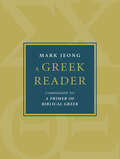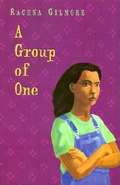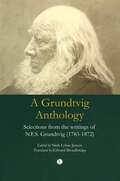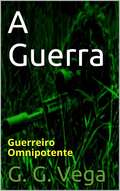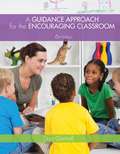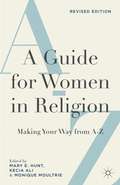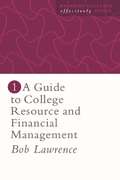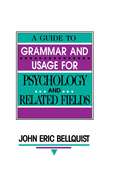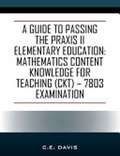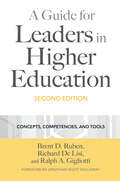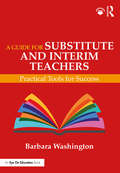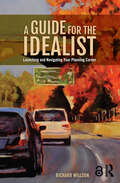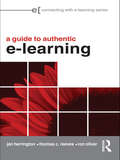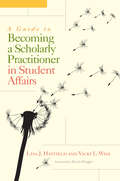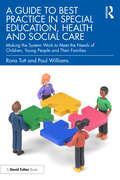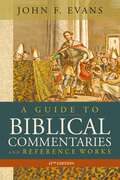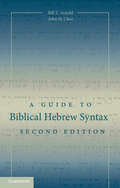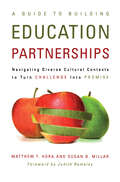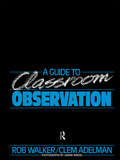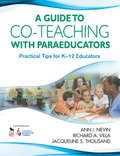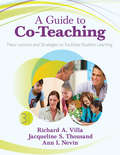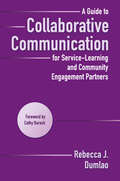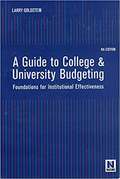- Table View
- List View
A Greek Reader: Companion to A Primer of Biblical Greek (Eerdmans Language Resources)
by Mark JeongA companion resource for use with N. Clayton Croy&’s Primer of Biblical Greek, featuring dozens of simple, enjoyable narratives to reinforce the content and skills introduced by Croy. Too often, Greek readers include difficult primary texts encumbered with glosses, but this reader from Mark Jeong is instead comprised of originally written texts keyed to the vocabulary and grammar taught in Clayton Croy&’s Primer of Biblical Greek. Thus fluent, comprehensive reading—rather than painstaking translation—can be the goal. In addition to providing useful practice, Jeong&’s engaging narratives will help students of Greek grasp the nuances of particularly complicated aspects of Koine—such as the imperfect tense—by allowing them to see the language &“in action&” in various textual situations. Each narrative also follows a larger story about the adventures of Philemon, Onesimus, and Paul, making for enjoyable reading that better prepares one for the daunting task of eventually reading the Greek New Testament.
A Group of One
by Rachna GilmoreLearning that her family was active in the Quit India movement of 1942, a rebellion against nearly two centuries of British occupation, gives 15-year-old Tara new pride in her heritage.
A Grundtvig Anthology: Selections from the writings of N.F.S. Grundtvig (1783-1872)
by Niels Lyhne JensenA notable figure in the cultural and social history of Denmark, Nikolaj Frederik Severin Grundtvig's (1783-1872) works are still salient for us now. Highlighting his vivacious ideas and personality, A Grundtvig Anthology includes extracts from Grundtvig's historical, educational, theological, devotional, and poetical works. Each chapter is prefaced by insightful explanatory introductions by leading authorities on Grundtvig's monumental body of work, along with a comprehensive general introduction and illuminating annotations. Grundtvig viewed the myths of the North as an expression of the moral values and understanding of life, and his hymn and song writing reveal the same joy of life, openness and freedom as the Norse perspective. By offering selections from across his major works, this anthology succeeds in capturing his spirit in English translation, and continuing his written legacy.
A Guerra
by Guido Galeano Vega Marili Gomes OliveiraEste é um livro que traduz a proposta de Deus para nós. Fala de Seu eterno amor pela humanidade.
A Guidance Approach for the Encouraging Classroom
by Dan GartrellA GUIDANCE APPROACH FOR THE ENCOURAGING CLASSROOM, 5/E, is for students in two- and four-year early childhood programs as well as graduate courses. It easily can function as a primary text in classes that address group management, the learning environment, child guidance, child behavior, challenging behavior, conflict management, and peace education topics. The text addresses ages 3 - 8 years in three parts. Part 1 explores the foundation of guidance in early childhood education and covers key concepts such as conventional discipline versus guidance, mistaken behavior, the guidance tradition, and innovative theories about child development with guidance. Part 2 focuses on building and organizing an encouraging classroom, as well as providing key elements of an encouraging classroom, including daily schedule, routines, use of thematic instruction, importance of working with parents, and leadership communication. Part 3 addresses problem solving and challenging behavior in the encouraging classroom, including a practical illustration for how to use and teach conflict management and coverage of the five-finger-formula. The book also covers nontraditional families as well as the effects of societal violence in the classroom. Throughout, this experience-based resource includes real-life anecdotes that allow professionals to make the shift from conventional classroom to developmentally appropriate guidance.
A Guide For Women In Religion, Revised Edition
by Mary E. Hunt Kecia Ali Monique MoultrieSignificantly updated and expanded, this indispensable resource offers students and scholars alike real advice in navigating the ever-changing academic landscape. Offering practical guidance on graduate school, dissertation-writing, job interviews, promotions, retirement, publications, conferences, and so much more, this is the essential resource.
A Guide To College Resource And Financial Management (Managing Colleges Effectively Ser. #Vol. 1)
by Robert P. LawrenceThis text is part of the "Managing Colleges Effectively" series that is designed for managers at all levels and governors of colleges in the new further education sector who are undertaking new and enhanced management tasks and responsibilities arising out of incorporation. This book is also relevant to similar areas in schools - particularly grant maintained and independent schools - and higher education generally.; This is an easy-to-read-and-follow practical book for non-specialist staff who have financial/resource management responsibilities as part of their jobs. It is aimed at the manager at all levels of the institutions and for those who want to know more about college finance and require a practical and comprehensive guide.
A Guide To Grammar and Usage for Psychology and Related Fields
by John Eric BellquistWhy another book on this topic? The author's experience editing leading journals in psychology suggests that publication manuals and books on writing about experimentation in psychology do not adequately address grammatical usage and style. Much of the advice published for scientific writers reads as if it had been written either by English teachers for writers who do not publish in scientific fields, or by scientific writers who think that the information already available in countless handbooks on grammar and style for student writers in English classes is enough. Unfortunately, such traditional handbooks do not offer the particular sorts of commentary that scientific writers need. This book offers specific advice on a host of issues ranging from the appropriate use of abbreviations to wordiness -- and how to avoid it. Dr. Bellquist's expertise in both the English language and the language of scientific writing ideally positions him to offer guidelines on the use of the passive, the best wording for statistical presentations, and just how to describe experimental procedures, among many other topics. Complete with examples and principles to guide writing decisions, this book will assist both students and seasoned professionals in presenting their work clearly for maximum impact. This book is intended as a guide to grammar and usage for writers in scientific fields -- particularly in experimental psychology and all fields related to experimental psychology. Features of the book include: * alphabetical entries and numerous cross references on grammar, usage, and style; * numerous examples taken from scientific papers or based on actual cases; * discussions of semantic problems of grammar such as modification, predication, and statement; * and discussions of usage specific to experimental psychology, statistics, and related fields.
A Guide To Passing The Praxis II Elementary Education: Mathematics Content Knowledge For Teaching (ckt) - 7803 Examination
by C. E. DavisThe purpose of this text is to provide a comprehensive source of information so that teacher candidates and practicing teachers needing the take the Praxis II: Elementary Education - Mathematics CKT (7803) test, will have a breadth of material to assist them in their success. This book will cover general strategies for progress, as well as specific test taking strategies which can be impactful while taking the examination. Another important section of this book deals strategies in combating anxieties with testing and mathematics, which plague several of us and can have negative repercussions. Additionally, the book will address testing standards, potential vocabulary and formulas, as well as provide over 100 questions for practice.
A Guide for Leaders in Higher Education: Concepts, Competencies, and Tools
by Ralph A. Gigliotti Brent D. Ruben Richard De LisiFIRST EDITION SPECIAL RECOGNITION:Winner of the 2018 Sue DeWine Distinguished Scholarly Book Award, National Communication Association, Applied Communication Division REVIEWS OF THE FIRST EDITION“The book provides frameworks and resources that would be highly relevant for new and aspiring department chairs. In fact, this text is ideally designed to serve as a selection for a book discussion group.”—The Department Chair“Succeeds in providing accessible and useful resources to individuals across different leadership roles… As a midpoint between textbook and reference work, it is successful at both and provides a clear and unbiased background to issues facing current leaders.”—Reflective TeachingDuring a time of unprecedented challenges facing higher education, the need for effective leadership – for informal and formal leaders across the organization – has never been more imperative.Since publication of the first edition, the environment for higher education has become more critical and complex. Whether facing falling enrollments, questions of economic sustainability, the changing composition of the faculty and student bodies, differential retention and graduation rates, declining public confidence in the enterprise, or the rise in the use of virtual technologies – not to mention how COVID-19 and an intensified focus on long standing issues of racial and gender representation and equity have impacted institutions and challenged many long-standing assumptions – it is clear that learning on the job no longer suffices. Leadership development in higher education has become essential for advancing institutional effectiveness, which is the focus of this book.Taking into account the imperative issues of diversity, inclusion, and belonging, and the context of institutional mission and culture, this book centers on developing capacities for designing and implementing plans, strategies, and structures; connecting and engaging with colleagues and students; and communicating and collaborating with external constituencies in order to shape decisions and policies. It highlights the need to think broadly about the purposes of higher education and the dynamics of organizational excellence, and to apply these insights effectively in goal setting, planning and change leadership, outcomes assessment, addressing crises, and continuous improvement at both the level of the individual and organization.The concepts and tools in this book are equally valuable for faculty and staff leaders, whether in formal leadership roles, such as deans, chairs, or directors of institutes, committees, or task forces, or those who perform informal leadership functions within their departments, disciplines, or institutions. It can be used as a professional guide, a textbook in graduate courses, or as a resource in leadership training and development programs. Each chapter concludes with a series of case studies and guiding questions.
A Guide for Substitute and Interim Teachers: Practical Tools for Success
by Barbara WashingtonIf you're a substitute or interim teacher, or thinking of becoming one, you won't want to miss the techniques and strategies in this user-friendly, easy-to-read book. Author Barbara Washington guides you through every step, including the application process, lesson planning, classroom management, and school safety. Each chapter offers practical examples and current best practices to support you on your way to success. The book also includes essential tools such as reproducible lesson plans, worksheets, graphic organizers, and more. Concise but complete, this is an ideal resource for substitute teacher professional development.
A Guide for the Idealist: Launching and Navigating Your Planning Career
by Richard WillsonA Guide for the Idealist is a must for young professionals seeking to put their idealism to work. Speaking to urban and regional planners and those in related fields, the book provides tools for the reader to make good choices, practice effectively, and find meaning in planning work. Built around concepts of idealism and realism, the book takes on the gap between the expectations and the constraints of practice. How to make an impact? How to decide when to compromise and when to fight for a core value? The book advises on career "launching" issues: doubt, decision-making, assessing types of work and work settings, and career planning. Then it explains principled adaptability as professional style. Subsequent chapters address early-practice issues: being right, avoiding wrong, navigating managers, organizations and teams, working with mentors, and understanding the career journey. Underpinning these dimensions is a call for planners to reflect on what they are doing as they are doing it. The advice provided is based on the experience of a planning professor who has also practiced planning throughout his career. The book includes personal anecdotes from the author and other planners about how they launched and managed their careers, and discussion/reflection questions for the reader to consider.
A Guide for the Idealist: Launching and Navigating Your Planning Career
by Richard WillsonA Guide for the Idealist is a must for young professionals seeking to put their idealism to work. Speaking to urban and regional planners and those in related fields, the book provides tools for the reader to make good choices, practice effectively, and find meaning in planning work. Built around concepts of idealism and realism, the book takes on the gap between the expectations and the constraints of practice. How to make an impact? How to decide when to compromise and when to fight for a core value? The book advises on career "launching" issues: doubt, decision-making, assessing types of work and work settings, and career planning. Then it explains principled adaptability as professional style. Subsequent chapters address early-practice issues: being right, avoiding wrong, navigating managers, organizations and teams, working with mentors, and understanding the career journey. Underpinning these dimensions is a call for planners to reflect on what they are doing as they are doing it. The advice provided is based on the experience of a planning professor who has also practiced planning throughout his career. The book includes personal anecdotes from the author and other planners about how they launched and managed their careers, and discussion/reflection questions for the reader to consider.
A Guide to Authentic e-Learning (Connecting with E-learning)
by Thomas C. Reeves Jan Herrington Ron OliverPart of the groundbreaking Connecting with e-Learning series, A Guide to Authentic e-Learning provides effective, working examples to engage learners with authentic tasks in online settings. As technology continues to open up possibilities for innovative and effective teaching and learning opportunities, students and teachers are no longer content to accept familiar classroom or lecture-based pedagogies that rely on information delivery and little else. Situated and constructivist theories advocate that learning is best achieved in circumstances resembling the real-life application of knowledge. While there are multiple learning design models that share similar foundations, authentic e-learning tasks go beyond process to become complex, sustained activities that draw on realistic situations to produce realistic outcomes. A Guide to Authentic e-Learning: develops the conceptual framework for authentic learning tasks in online environments provides practical guidance on design, implementation, and evaluation of authentic e-learning tasks includes case studies and examples of outcomes of using authentic e-learning tasks Written for teaching professionals in Higher Education who teach online, A Guide to Authentic e-Learning offers concrete guidelines and examples for developing and implementing authentic e-learning tasks in ways that challenge students to maximize their learning. This essential book provides effective, working examples to engages learners with authentic tasks in online learning settings.
A Guide to Becoming a Scholarly Practitioner in Student Affairs
by Lisa J. Hatfield Vicki L. WiseStudent affairs professionals are increasingly being called upon to become scholar practitioners, to reflect on and share their experiences to further the knowledge of the field, and to disseminate practices to promote student learning and development. This book offers practical guidance to anyone in the field interested in presenting at conferences or publishing in scholarly and professional journals, and sets the work of scholarly practice in the context of its vital role of influencing and shaping the future of student affairs, and in promoting continuous learning.The authors demystify the processes of producing research and scholarly work; address motivation and barriers such as time-constraints or confidence; and provide advice on developing ideas, writing, getting feedback, staying on task, identifying the appropriate outlets and venues for ideas, submitting proposals, as well as on speaking and presentation skills. It also directs readers to books and online resources and presents the reflections of senior student affairs officers on scholarship in the profession. As the authors state, student affairs professionals are often in the best position to test the myths about what really works for college students to have access, persist, and graduate. Through their daily interactions with students they develop the grounding for theories and strategies to improve the college experience, none of which can be advanced without scholarship, without presenting and writing, and the debate that they stimulate.This book is intended for student affairs professionals at all levels. It sets the context for those starting their careers as they navigate and understand their new roles; aims to inspire mid-level professionals to present or write about their experiences and contributions; and offers senior administrators strategies to pursue their own scholarship while creating a supportive environment for their staff to do so, and develop their agency and professional growth in the process.
A Guide to Best Practice in Special Education, Health and Social Care: Making the System Work to Meet the Needs of Children, Young People and Their Families
by Paul Williams Rona TuttA Guide to Best Practice in Special Education, Health and Social Care explores and explains the changes in governmental policies across the education, health and social care services, and what they mean for young individuals, parents and professionals. In a period of significant change, many practitioners need to understand the government’s plans for bringing about a more efficient, effective and sustainable system to meet the needs of young people and their families. Without trawling through reviews, green papers, white papers and bills, this book not only explains the significance of recent events, but provides practical examples, in the form of conversations and case studies, about how parents and professionals are making change happen. With decades of experience, Rona Tutt and Paul Williams delve deep into the separate origins of the three strands – the SEND Review, the review of children’s social care, and the Health and Care Act 2022. The book explores how pupils in different types of schools can have their needs met more effectively; how to make better use of available resources; and how to create a culture of mutual respect across all the three services.A Guide to Best Practice in Special Education, Health and Social Care not only fills in gaps in readers’ knowledge about the working of all three services, but provides innovative examples of how change is happening at ground level. People of all age groups working in schools and seeking to enhance their knowledge will find it to be an essential read. It will also be of interest to parents and professionals from across health and social care.
A Guide to Bible Basics
by Tyler MayfieldWhat's actually in the Bible? Where do we find the story of Moses or Jesus's Parable of the Prodigal Son? Who are the main characters in the books of Joshua and Acts? A Guide to Bible Basics provides a summary and chapter outline of each biblical book to facilitate comprehension of its fundamental story and subject matter. This accessible and concise book presents the basic content of the Bible with the conviction that readers first need some level of comprehension of the Bible's stories, poetry, regulations, and teachings before addressing theological, historical, and literary concerns for its relevance today. Tyler Mayfield discusses important people, places, and terms so that the reader can quickly see the primary focus. This book can be used alone to help readers in their knowledge of the Bible and is great for beginners or those in need of a refresher course.
A Guide to Biblical Commentaries and Reference Works, 11th Edition
by John F. EvansA Guide to Biblical Commentaries and Reference Works, 11th Edition by John F. Evans, summarizes and briefly analyzes all recent and many older commentaries on each book of the Bible, giving insightful comments on the approach of each commentary and its usefulness for biblical interpretation. The easy-to-use book provides analysis in canonical order and includes helpful appendices for compiling a personal research library. A Guide to Biblical Commentaries and Reference Works, 11th Edition, is a key reference tool for any student of the Bible--pastors, laity, and scholars alike.
A Guide to Biblical Hebrew Syntax
by Bill T. Arnold John H. ChoiA Guide to Biblical Hebrew Syntax introduces and abridges the syntactical features of the original language of the Hebrew Bible/Old Testament. An intermediate-level reference grammar for Biblical Hebrew, it assumes an understanding of elementary phonology and morphology, and it defines and illustrates the fundamental syntactical features of Biblical Hebrew that most intermediate-level readers struggle to master. The volume divides Biblical Hebrew syntax and morphology, into four parts. The first three cover the individual words (nouns, verbs, and particles) with the goal of helping the reader move from morphological and syntactical observations to meaning and significance. The fourth section moves beyond phrase-level phenomena and considers the larger relationships of clauses and sentences. Since publication of the First Edition, research on Biblical Hebrew syntax has substantially evolved. This new edition incorporates these developments through detailed descriptions of grammatical phenomena from a linguistics approach. It retains the labels and terminology used in the First Edition to maintain continuity with the majority of entry-level and more advanced grammars.
A Guide to Building Education Partnerships: Navigating Diverse Cultural Contexts to Turn Challenge into Promise
by Matthew T. Hora Susan B. MillarEducation partnerships are central to – and often a requirement of – most education reform initiatives promoted by state and local governments, by foundations, and by business funders. Many fail for failure to understand the dynamics of their complex relationships.This book provides insights and guidance to enable prospective and existing education partners to develop answers to the questions that are critical to success: Why engage in this partnership? How can you communicate the potential benefits of partnership to motivate teachers, faculty, administrators, and community members? How do you select the best organizational structure and procedures for a partnership? How can you maintain open, deliberative discussion while respecting different histories and cultures? How can you produce compelling evidence that the partnership is worthwhile? Based on their observation of a five-year-long publicly funded partnership, research data, and the literature, the authors identify the principles that they consider critical to answering these questions. The authors do not minimize the differences and complexities inherent in partnership work, because they believe that doing so would be to present coherence and homogeneity where none exists. Instead, they seek to make evident how these principles underlie many different partnership situations. Thus, rather than presenting a package of best practices, or a cookie-cutter approach, this book presents the organizational principles for planning and implementing education partnerships, along with sets of strategies for working through them. The authors present the diagnostic tools for undertaking a deliberate and research-based approach to planning, designing, and managing a partnership. By surfacing participants’ often-differing motivations, and the practices and assumptions they bring to the table, the book provides the foundation for developing a constructive relationship. In scope, the book extends beyond school-university partnerships to include schools’ collaboration with state and local governments, nonprofit organizations, and the business sector.
A Guide to Classroom Observation
by Clement Adelman Clem Adelman Roy WalkerFor many student teachers the classroom is a strange and potentially uncontrollable environment. This book shows how the period of classroom observation, which for most students precedes teaching practice, plays an important part in this transition process.
A Guide to Co-Teaching With Paraeducators: Practical Tips for K-12 Educators
by Richard A. Villa Jacqueline S. Thousand Ann I. NevinLearn how paraeducators can positively impact the achievement of students with special needs in the inclusive classroom! This comprehensive guide outlines how teachers and paraeducators can work together to improve outcomes for students with special needs while meeting standards in a climate of accountability. The authors highlight four approaches to co-teaching and school-system supports that allow for appropriate supervision and ongoing training. The book also provides: <p><p> Reproducible forms that teachers and paraeducators can use to establish effective co-teaching roles <p> Real-life accounts of three paraeducators <p> Concept maps, chapter summaries, and a glossary of terms for easy navigation
A Guide to Co-Teaching: New Lessons and Strategies to Facilitate Student Learning
by Richard A. Villa Jacqueline S. Thousand Ann I. NevinYour go-to guide for co-teaching! When you and a co-teacher bring together your individual skill sets and strategies, you'll create a more enjoyable, creative, and productive teaching experience—with more effective outcomes for students. Featuring updated research and case studies, this brand-new edition of the go-to guide profiles the supportive, parallel, complementary, and team-teaching approaches to co-teaching. New features include: Updated discussions of co-teaching in the RTI process New explorations of the roles of paraprofessionals, administrators, and even students New lesson plans linked to the Common Core and technology Forms and tools for establishing trust, improving communication, and planning
A Guide to Collaborative Communication for Service-Learning and Community Engagement Partners
by Rebecca DumlaoThis book focuses on partnerships at the most basic level of interaction – between two people as they work toward common goals. Interpersonal dynamics described in this book are intended to guide formal and institutional relationships between members of a community or community organization on the one hand and representatives from campus on the other. Collaborative communication principles and practices shared can form a foundation for individuals to build flexible, lasting relationships that will weather most challenges and sustain the larger partnerships of their respective organizations.This book offers a conceptual framework of collaborative communication to build and sustain partnerships, recognizing that relationships change over time as the people involved and their circumstances evolve. Collaborative communication uses a repertoire of knowledge and skills that allow partners to make choices that fit their situation or context and to work through differences and challenges as they occur, to include managing conflict and navigating cultural differences. It further takes into account the different means of communication, whether face-to-face, using e-mail, text messaging, or social media. Readers will appreciate the numerous real world examples that illustrate and bring its key concepts to life.This book is addressed to partners at all levels focused on community engagement and service-learning. It is intended for preparing college students to work more effectively in the community, as well as for workshops for community and campus members who work with service-learning students. It can equally be used in leadership workshops in academic and community settings. Scholars, students, or community members involved in community engaged research will also find useable ideas for their work. The appendices offer an annotated bibliography of useful resources and provide readers with a repertoire of activities for building a collaborative communication repertoire.
A Guide to College and University Budgeting: Foundations for Institutional Effectiveness
by Larry Goldstein Sandra SaboBudgeting is inherently political, too often short-term goals overrun long-term institutional interest. By presenting the many layers and budgeting models with a clear, comparative framework, author Larry Goldstein, demonstrates the organic link between planning and budgeting making it crystal clear that budgets and plans represent two sides of the same coin. Updated throughout to account for recent issues in budgeting, the fourth edition includes coverage of factors essential to the success of the budgeting process, including open communication with stakeholders, clear articulation of the budget to the strategic plan, budget implementation and monitoring process and the role of technology. This book also offers new academic administrators and faculty: - An introduction to budgeting ·Economic and political factors affecting the process - How to budget in difficult financial times - An insight on the role of the Board in applying various budgeting approaches
